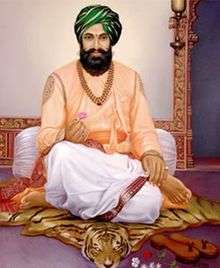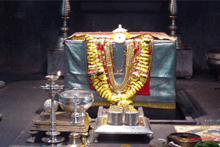Manik Prabhu
| Manik Prabhu Maharaj | |
|---|---|
 | |
| Born |
1817[1] Ladwanti, Basavakalyan |
| Died |
1865 (aged 47–48) [2] |
| Nationality | Indian |
| Founder of | Sakalamata Sampradaya |
| Philosophy | Advaita Vedanta |
Manik Prabhu was an early 19th century Hindu saint, philosopher, poet and mystic.[3] He is also regarded as an incarnation of Dattatreya by the people of Datta Sampraday. Prabhu's philosophy, The SAKALAMATA SIDDHANTA basically rests on the principles of Advaita Vedanta as propagated by Adi Sankara. Manik Nagar is the place where he took Sanjeevani Samadhi.



Early life
Manik Prabhu was born to Manohar naik and Baya Devi, a Bramhin couple, on 22 December 1817 (Margashirsha Pournima - Datta Jayanti) in his maternal grandparent's house at Ladwanti near Basavakalyan (Now in the Bidar district of Karnataka.).[4] He lost his father at an early age and thus grew up under the guardianship of his uncle, who was employed with the nawab of Basavakalyan. As he grew older, his uncle tried to formally educate him, thinking that education would make him a breadwinner for the family, but in vain. On a hot summer afternoon, when Prabhu was taking a royal siesta on his uncle's bed, he got a strong reprimand from his uncle. This was reason enough for Prabhu to renounce all worldly ties and leave his hometown for his chosen mission. After leaving home, Prabhu travelled on foot as a wandering Yogi across the length and breadth of the country covering all places of religious importance such as Varanasi, Haridwar, Badri, Puri, Dwarka, Tirupati and Rameshwaram. During his countrywide travel, he composed numerous bhajans in praise of various deities in Marathi, Kannada, Hindi, Urdu and Sanskrit. These Bhajans and Abhangas are compiled in book called Padyamala.[5]
Maniknagar
After completing his spiritual journey across the country, Prabhu finally decided to settle on the banks of the rivulets Viraja and Guruganga in the year 1845 which later came to be konown as Maniknagar (a place near Humnabad in Bidar District of Karnataka).[6] Maniknagar thus became his permanent abode and also a center for the propogation of his philosophy of SAKALAMATA SIDDHANTA. Manik Prabhu established the GAADI (spiritual seat) of Lord Dattatreya in the very hut where he used to reside. The unique thing about it was that he did not place any idol or spiritual icon on the GAADI and instead decided to keep it empty. The idea behind it was that his devotees could visualise the PARABRAMHA(The supreme reality), in whatever form they liked and worship him accordingly. The name and fame of Manik Prabhu spread quickly like a wildfire and people of all religions, sects and communities started flocking to Maniknagar. Prabhu used to held a gathering everyday called DARBAR where thousands of people visited him and sought his blessings.[7] Prabhu guided his devotees in spiritual matters and even helped them overcome their material difficulties. Prabhu was equally revered by all communities while his Muslim followers thought him to be an incarnation of Mehboob Subhani(The famous Sufi saint of Baghdad), his Lingayat devotees would worship him as Lord Basaveshwara and his sikh followers saw him as in the form of Guru Nanak.[8] Stories of his miracles and eye witness accounts, which bear testimony to the manner in which he brought succor to the distressed and the sorrowing, to the afflicted and the wronged, who, ardently and with deep faith and devotion sought his spiritual intervention are available. Prabhu attained Sanjivini Maha-Samadhi on a pre-determined day in the Hindu Lunar Month of Margasheersha(Mokshada Ekadashi or Geeta Jayanti - 29 November 1865). With his Maha-Samadhi, Maniknagar, the abode of Shri Prabhu, became the head quarters of Shri Manik Prabhu Samsthan and also a place of attraction for the people who have been visiting this place to pay their respects to the holy Samadhi of Shri Prabhu.
Guru Prampara
Maniknagar is the only Datta-Peetha where a Guru-Parampara exists for the spiritual guidance of the devotees. Prabhu's mission was ably carried forward by his successors - Shri Manohar Manik Prabhu,[9] Shri Martand Manik Prabhu,[10] Shri Shankar Manik Prabhu[11] and Shri Siddharaj Manik prabhu.[12] Presently, Shri Dnyanraj Manik Prabhu is the Peethadhipati of Shri Manik Prabhu Samsthan .[13]
Sakalamata Sampradaya
[14] [15] The meaning of Sakalmat is that all faiths are accepted (Sakala means All and mata means opinion, but here we have to take the meaning as faith). This is a form of Datta-sampradaya which is called Rajyog or Royal type. This Sampradaya has three types of Upasanas (Ways of Worship). The first is Adhyatmic Upasana, in which Chaitanya Dev(Bramhan) is the main Deity. The Second is Adhidaivik Upasana which has Dattatreya as its Deity. The third is Adhibhautik Upasana in which Manik Prabhu is worshiped as the fourth incarnation of lord Dattatreya. Here, poor and rich are considered as the same. Thus all the materialistic items are viewed at par with nothing. The philosophy of this tradition is that there is no resistance to any kind of religious faiths in the world. All faiths are believed to give the ultimate godliness to its followers. This tradition was started by Shri Manik Prabhu of Maniknagar. Hindus, Muslims and people of all castes are allowed here.[16] Shri Sai Baba of Shirdi, Shri Swami Samarth of Akkalkot, Shri Bramhachaitanya of Gondavale and many other contemporary saints are believed to have visited Maniknagr to interact with Prabhu on matters of deep spiritual wisdom.[2]
Datta Jayanti
Manik Prabhu is the only saint in Datta Sampradaya who was born on Datta Jayanti[17] i.e. Margashirsha Pournima. Prabhu's birth anniversary is celebrated in Manik nagar as an annual 7-day Mahotsava called Datta Jayanti mahotsava. It is a religious and cultural extravaganza in which hundreds of vedic Pundits, Musicians, Folk artists along with lakhs of devotees assemble in Maniknagar to pay their tributes to the Samadhi of Manik Prabhu. It concludes with an event called Darbar, after the Birth Celebrations of Manik Prabhu.
References
- ↑ Bhawuk, Dharm (2011). Spirituality and Indian Psychology: Lessons from the Bhagavad-Gita. Springer. p. 27. ISBN 1441981101.
- 1 2 V. B. Kher (1991). Sai Baba of Shirdi. Jaico Publishing House. ISBN 8172240309. Retrieved 23 May 2014.
- ↑ History and legend in Hyderabad. Department of Information and Public Relations, Hyderabad (India). 1953. p. 36.
- ↑ http://manikprabhu.org/shri-manik-prabhu-maharaj/
- ↑ http://manikprabhu.org/purchase-books-online/
- ↑ http://manikprabhu.org/how-to-reach/
- ↑ http://saiamrithadhara.com/bidar.html
- ↑ http://manikprabhu.org/vision-and-mission/
- ↑ http://manikprabhu.org/shri-manohar-manik-prabhu/
- ↑ http://manikprabhu.org/shri-martand-manik-prabhu/
- ↑ http://manikprabhu.org/shri-shankar-manik-prabhu/
- ↑ http://manikprabhu.org/shri-siddharaj-manik-prabhu/
- ↑ http://manikprabhu.org/shri-dnyanraj-manik-prabhu/#
- ↑ https://books.google.com/books/about/Dakhani_Hindi_aura_sakalamata_sampradaya.html?id=m93omgEACAAJ&redir_esc=y
- ↑ http://www.manikprabhu.org/Philosophy
- ↑ http://www.shreeswami.org/avatars/shri-manik-prabhu-maharaj/.
- ↑ http://manikprabhu.org/datta-jayanti-mahotsava/